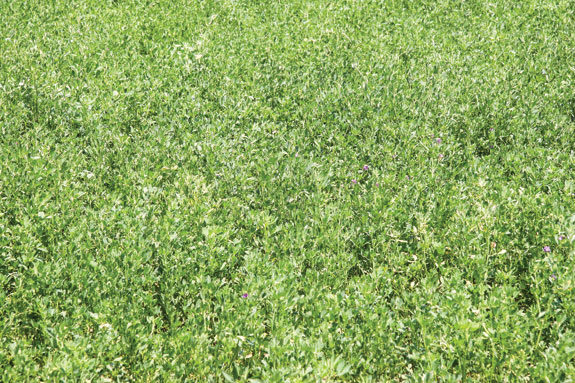To begin with, the yearly production cycle starts with planning and continues on through harvest to feeding.
There are several factors that can affect production throughout this cycle. With such robust advances in technology, as well as an increased depth of understanding for production aspects, we are more equipped to help reduce these production-limiting factors.

We now have the opportunity to reveal the full yield capacity held within the soil and plant genetics.
Looking mainly at the alfalfa industry in this article, it’s reflective of the old English proverb, “Necessity is the mother of invention.” It’s our goal to achieve more production, while balancing forage quality and soil stewardship.
This necessity has been the driving force behind many of the industry’s innovative discoveries. To help achieve this goal, tremendous focus has been placed on reducing as many of the production-limiting factors as we can. Let’s take a closer look at a few factors in the alfalfa production cycle serving that purpose.
Alfalfa plant genetics
New industry discoveries: Great strides are being made to help increase forage quality, such as lowering lignin levels and increasing digestibility – resulting in an increase in animal production, while decreasing manure output.
Another area starting to be studied is tannins in alfalfa and how they can help reduce protein losses in the rumen, reducing protein supplementation.

Soil management/fertility
Industry crop management programs: Yield starts here. There are some amazing crop management computer programs helping manage all crop production functions, from precise grid soil sampling to data management – the key to revealing production-limiting factors.
Armed with soil test results, the program helps create and design a full-season plan that includes variable rate fertility based on soil test reports, along with variable rate planting based on soil type and fertility condition.
Tissue sampling and soil resin balls: With huge rise in commodity prices, this is an area of rapid growth. As the growing season evolves, tissue sampling has become an important fertility management tool.
Another even newer test, still in the early stages of development, uses a specially designed resin ball to help identify fertility deficiencies within the actual root zone. This information will then allow us to supplement deficient nutrients at the correct time.
The bottom line is to design a powerful plant diet that will reduce any nutritional limitations, while digitally tracking to better assist management with planning.
Near-infrared mapping: Kansas State University Department of Agronomy is working on a major development to help farmers get to a new yield level – a drone (radio-controlled aircraft) capable of capturing near-infrared, natural color and video.

Such technology can be used for studying plant productivity, monitoring plant growth stages, assessing plant health and mapping plant composition for characterizing changes in distribution of invasive and toxic plant species.
Seed
Seed treatment innovations: I recently came across an alfalfa seed advertisement for The Albert Dickinson Co. from 1926, which encouraged producers to clean seed before planting.
While the industry has evolved, clean seed has certainly become a tradition in the seed industry.
Today, we have top-notch seed quality programs that ensure we are planting only the best and highest quality seed.
To accompany quality programs, we now have new seed treatments – all created to set the seed up for total emergence success.
As our yield goals continue to increase, it’s comforting to know we can count on many new discoveries to help us reach them, with more to come in the future. FG
References omitted due to space but are available upon request. Click here to email an editor.
PHOTO
To achieve the goal of higher production while balancing forage quality and soil stewardship, tremendous focus has been placed on reducing as many production-limiting factors as possible. Photo courtesy of FG staff.












